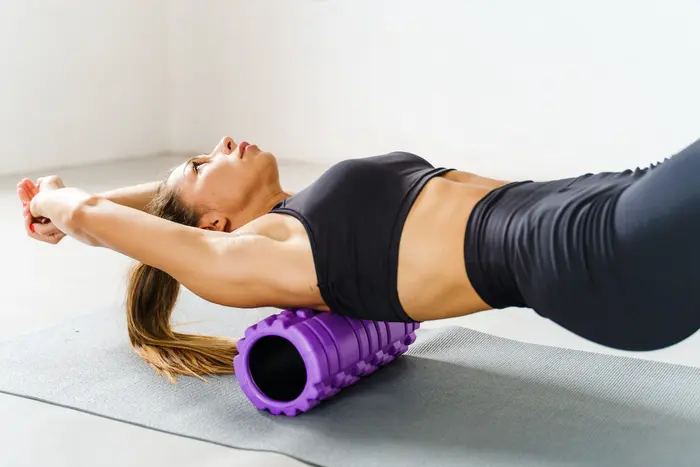Rolling Back on Foam Roller: The Ultimate Guide
Long reserved for professional athletes and physical therapists, foam rolling has evolved into a pillar of exercise and recuperation regimens all around. The concept of rolling back on a foam roller, its benefits, approaches, and advised practices to maximize its efficacy is investigated in this research. This guide will enable you to release the possibilities of foam rolling independent of your degree of experience as an athlete or someone looking to alleviate back tension.
Foam rolling is a version of self-myofascial release (SMR) used to reduce muscle tension, discomfort, and inflammation while boosting general mobility.
Rolling back on a foam roller addresses particularly the method of emphasizing the back muscles. Apart from reducing back pain, this method enhances flexibility and posture. Foam rolling offers a quick remedy for lengthy sitting’s effects and poor posture as inactive lives become more prevalent.
This article will walk you through the science behind foam rolling, the benefits of focusing on the back, and thorough recommendations to ensure you are doing it safely and effectively.

Understanding Foam Rolling
What is Foam Rolling?
Using a cylindrical tool known as a foam roll, foam rolling is exerting pressure to muscles and fascia. Fascia is the connective tissue that may become tight or constrained from stress, trauma, or inactivity; surrounded and supporting muscles. Helping to remove these restrictions aids foam rolling to reduce discomfort and improve movement.
Why Rolling Back on Foam Roller Matters
Among the most tight areas of the body is the back. Bad posture, extended seated time, and intense exercise can all cause tightness and pain. Using a foam roller in reverse will enable you:
- Release tensions in upper, middle, and lower back.
- Correct spinal mobility and posture.
- Minish muscular knots and boost back muscle circulation.
Benefits of Rolling Back on a Foam Roller
1- Relieves Muscle Tension and Knots
Common in the back, muscular knots—also known as trigger points—are brought on by stress and repeated actions. Foaming rolling targets these knots with concentrated pressure helps to release tension and restore normal muscular movement.
2- Improves Posture
Usually, back pain comes from bad posture. Once foam rolling the back releases tight muscles and realigns the spine, maintaining an upright posture becomes easier.
3- Enhances Blood Circulation
Rolling promotes blood flow to the back muscles, providing oxygen and nutrients supporting healing and reduction of pain.
4- Reduces Stiffness
Back pain from either extended sitting or intense exercise could limit motion. Ordinary foam rolling helps to improve range of motion and flexibility, enabling ordinary everyday chores.
5- Boosts Recovery
Foam rolling is a useful technique for recovery especially after exercise. It accelerates healing and helps lactic acid be drained out, therefore reducing post-exercise soreness.

Step-by-Step Guide to Foam Rolling Your Back
1. Choose the Right Foam Roller
Densities and textures abound on foam rollers. Regarding back rolling, give some thought:
- Soft Foam Rollers: Perfect for sensitive muscles and novices.
- Medium-Density Rollers: Offer a harmony between pressure and comfort.
- Firm Rollers: For skilled users and deep tissue massages especially.
2. Prepare Your Body
Before foam rolling, warm up using either modest aerobic or dynamic stretches. This increases blood flow and helps your muscles be pressure ready.
3. Proper Technique for Rolling Back on Foam Roller
Use these guidelines for back rolling that works:
- Step 1: Lay on the floor with the foam roller horizontal behind you.
- Step 2: Back off so the roller rests beneath your upper back.
- Step 3: Keeping your feet flat on the floor, bend at the knees.
- Step 4: To expose the back muscles, cross your arms over your chest.
- Step 5: Rising gently from the ground, roll the roller up and down your back with your feet.
- Step 6: Spend twenty to thirty seconds on each of the focused, tight areas.
4. Avoiding Common Mistakes
- Rolling Too Fast: Go gently to let muscles change to fit the pressure.
- Holding Your Breath: To foster calm, inhale deeply.
- Rolling the Lower Spine: To avoid damage, avoid pressing the lower spine straight forwardly.
5. Duration and Repetition
Spend one to two minutes rolling your back, focusing especially on each component. For best results, schedule daily or following workouts.
When and How Often Should You Use a Foam Roller?
- Daily Use: Add foam rolling to your daily workout routine to help with stress and effects of a sedentary lifestyle.
- Post-Workout Recovery: After exercise, foam rolling speeds up healing time and releases muscular tension.
- Morning or Evening Routine: Either start your day with foam rolling to increase mobility or relieve tension and therefore relax your muscles before bed.
Precautions and Contraindications
Who Should Avoid Foam Rolling?
- Anyone with ruptured discs, major back issues, or osteoporosis should visit a doctor before foam rolling.
Tips to Prevent Injury
- Avoid rolling straight on bones or joints.
- Use a mild foam roller if you have sensitive muscles or are brand-new to the exercise.
- Stop if you have sharp or severe pain.
Frequently Asked Questions (FAQs)
Can Foam Rolling Replace Professional Massages?
Though a great self-care method, foam rolling cannot replace the knowledge of a licensed massage therapist.
Is Foam Rolling Safe for Everyone?
Although foam rolling is generally safe, anyone having specific medical conditions should see a doctor.
How Do I Know If I’m Doing It Correctly?
One has to use good technique. Go gently; focus on muscular areas; avoid rolling on joints or bones.
Why Does Foam Rolling Feel Uncomfortable?
Many times, pain during foam rolling indicates tight or strained muscles. Regular exercise over time reduces sensitivity.
Conclusion: Rolling Back on Foam Roller
Foam rolling your back is a simple yet powerful method for muscle rehabilitation, tension release, and more overall mobility. This can help you have a healthier, more flexible back and avoid common issues such stiffness and discomfort in your daily schedule.
Starting your foam rolling journey right now will enable you to experience the transformative powers personally. We would love to hear your story; share your ideas and growth in the space provided for comments below.
